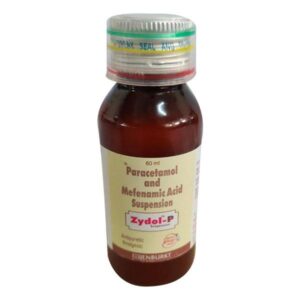PARACETAMOL + MEFANAMIC ACID
Paracetamol: Paracetamol, also known as acetaminophen, is a widely used over-the-counter (OTC) medication for pain relief and fever reduction. It belongs to the class of analgesic and antipyretic drugs.
Use: Paracetamol is commonly used to alleviate mild to moderate pain, such as headaches, toothaches, muscle aches, and menstrual cramps. It is also effective in reducing fever. It is widely available in various forms, including tablets, capsules, liquid suspension, and suppositories.
Mechanism of action: The exact mechanism of action of paracetamol is not fully understood. However, it is believed to work by inhibiting the production of prostaglandins, chemicals in the body that contribute to pain perception and fever. This drug mainly targets the central nervous system (CNS) to provide pain relief and reduce fever.
Dose: The recommended dose of paracetamol varies based on age and weight. For adults and children over 12 years, the usual dose is 500-1000 mg every 4-6 hours, not exceeding 4000 mg per day. For children, the dosage should be adjusted according to their age and weight, following the instructions provided by a healthcare professional.
Side effects: Paracetamol is generally considered safe when used as directed. However, like any medication, it can have side effects. Common side effects include mild gastrointestinal discomfort, such as nausea or an upset stomach. In rare cases, allergic reactions like skin rash or swelling may occur. It is important to be cautious about the risk of liver damage when taking high doses or using paracetamol for an extended period. Overdose of paracetamol can be toxic to the liver and may result in severe liver damage or even failure if not treated immediately.
It is essential to read the instructions and follow the recommended dosage guidelines when using paracetamol. If you have any concerns or experience severe side effects, it is best to consult a healthcare professional or pharmacist.
Mefanamic Acid: Mefenamic Acid is a nonsteroidal anti-inflammatory drug (NSAID) that is commonly used to relieve mild to moderate pain, particularly menstrual pain (dysmenorrhea). It can also be used to treat other types of pain, such as muscle aches, headaches, and dental pain.
The exact mechanism of action of mefenamic acid is not completely understood, but it is believed to work by inhibiting the production of substances called prostaglandins. Prostaglandins are chemicals in the body that contribute to pain, inflammation, and fever. By inhibiting their production, mefenamic acid helps to reduce pain and inflammation.
The usual dose of mefenamic acid for adults is 500 mg as an initial dose, followed by 250 mg every 6 hours as needed for pain relief. It should be taken with food to reduce the risk of stomach upset. The total daily dose should not exceed 1500 mg.
Like other NSAIDs, mefenamic acid can cause side effects. Common side effects include stomach pain, nausea, indigestion, vomiting, diarrhea, and dizziness. It may also cause allergic reactions, such as rash, itching, swelling, or difficulty breathing. In rare cases, mefenamic acid can cause severe skin reactions or liver problems. It is important to seek medical attention if any of these side effects occur.
It is worth noting that mefenamic acid should not be used by individuals who are allergic to NSAIDs, have a history of stomach or intestinal bleeding, have a history of allergic reactions to aspirin or other NSAIDs, have severe liver or kidney problems, have a bleeding disorder, or are in the last trimester of pregnancy. It is always best to consult a healthcare professional before starting any medication to ensure it is safe and appropriate for you.

